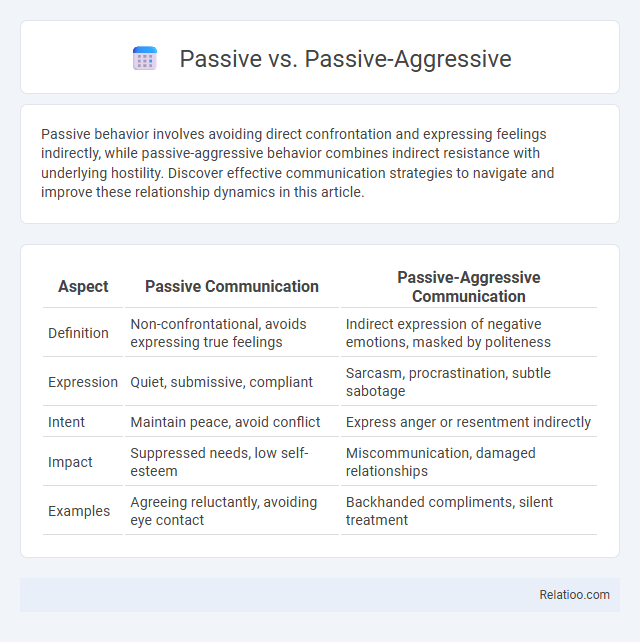Passive behavior involves avoiding direct confrontation and expressing feelings indirectly, while passive-aggressive behavior combines indirect resistance with underlying hostility. Discover effective communication strategies to navigate and improve these relationship dynamics in this article.
Table of Comparison
| Aspect | Passive Communication | Passive-Aggressive Communication |
|---|---|---|
| Definition | Non-confrontational, avoids expressing true feelings | Indirect expression of negative emotions, masked by politeness |
| Expression | Quiet, submissive, compliant | Sarcasm, procrastination, subtle sabotage |
| Intent | Maintain peace, avoid conflict | Express anger or resentment indirectly |
| Impact | Suppressed needs, low self-esteem | Miscommunication, damaged relationships |
| Examples | Agreeing reluctantly, avoiding eye contact | Backhanded compliments, silent treatment |
Understanding Passive Behavior
Passive behavior often involves avoiding direct communication and suppressing personal needs to prevent conflict, characterized by compliance and withdrawal. Unlike passive-aggressive behavior, which expresses negative feelings indirectly through sarcasm or procrastination, passive behavior lacks hidden hostility and maintains outward calmness. Understanding passive behavior requires recognizing its roots in fear of rejection or desire for approval, which can lead to internalized frustration and diminished self-expression.
Defining Passive-Aggressive Behavior
Passive-aggressive behavior is characterized by indirect resistance and hidden hostility, where individuals express negative feelings through subtle actions instead of open communication. Unlike passive behavior, which involves avoiding confrontation and yielding to others, passive-aggressive individuals use sarcasm, procrastination, or stubbornness to convey displeasure. Frustration often triggers passive-aggressive tendencies, leading to ineffective conflict resolution and strained relationships.
Key Differences Between Passive and Passive-Aggressive
Passive behavior involves avoiding direct confrontation and expressing feelings indirectly, often leading to suppressed emotions. Passive-aggressive behavior disguises hostility through subtle, indirect actions like procrastination or sarcasm, masking true feelings behind a facade of compliance. Understanding these distinctions helps you recognize frustration's role in transforming passive tendencies into passive-aggressive responses, enabling better emotional management and communication.
Common Signs of Passive Communication
Common signs of passive communication include avoiding eye contact, hesitating to express opinions, and frequently apologizing even when not at fault. Individuals exhibiting passive behavior often suppress their true feelings to avoid conflict, leading to internalized stress and resentment. Understanding these signs helps distinguish passive communication from passive-aggressive behavior, where hidden hostility is masked by seemingly passive actions.
Typical Traits of Passive-Aggressive Responses
Passive-aggressive responses often display indirect resistance, such as procrastination, sarcasm, and subtle sabotage, distinguishing them from straightforward passive behavior, which involves avoidance and compliance without confrontation. Individuals exhibiting passive-aggressive traits may outwardly agree yet internally harbor resentment, leading to behavior that undermines communication and trust. This pattern contrasts with frustration, which is an emotional state manifesting as visible irritation or anger, whereas passive-aggressiveness masks these emotions behind seemingly cooperative actions.
Impact on Relationships and Workplaces
Passive communication often leads to misunderstandings and unmet needs, causing strain in both relationships and workplaces. Passive-aggressive behavior creates a toxic environment by fostering mistrust and subtle conflicts that undermine team cohesion and personal connections. Your ability to recognize and address these behaviors promotes healthier interactions and more productive collaboration.
Psychological Roots of Each Behavior
Passive behavior often stems from a fear of confrontation or low self-esteem, where individuals avoid expressing their true feelings to maintain harmony. Passive-aggressive behavior arises from suppressed anger or resentment, where indirect actions communicate discontent without overt confrontation. Frustration is a direct emotional response to blocked goals or unmet needs, highlighting internal tension that may lead to varied expressions depending on your coping mechanisms.
How to Recognize Your Own Communication Style
Recognizing your own communication style involves observing how you express feelings and respond to conflict; passive communication often avoids confrontation and suppresses needs, while passive-aggressive behavior disguises anger through indirect actions or sarcasm. Frustration manifests through tense body language or abrupt speech, signaling underlying dissatisfaction without clear expression. Awareness of these patterns in your dialogue helps you adjust your approach for clearer, more effective communication.
Strategies to Address Passive and Passive-Aggressive Tendencies
Effective strategies to address passive and passive-aggressive tendencies involve clear communication and setting firm boundaries to encourage assertiveness and emotional expression. Encouraging self-reflection and providing constructive feedback can help you recognize hidden frustrations and promote healthier interaction patterns. Utilizing role-playing or cognitive-behavioral techniques improves your ability to respond directly rather than resorting to indirect or hostile behaviors.
Moving Toward Assertive Communication
Passive communication avoids expressing feelings or needs, leading to unmet desires and resentment. Passive-aggressive behavior indirectly expresses anger through subtle sabotage or sarcasm, creating confusion and tension. Frustration can escalate when communication is unclear; moving toward assertive communication promotes honest expression, clear boundaries, and respectful dialogue to resolve conflicts effectively.

Infographic: Passive vs Passive-Aggressive
 relatioo.com
relatioo.com